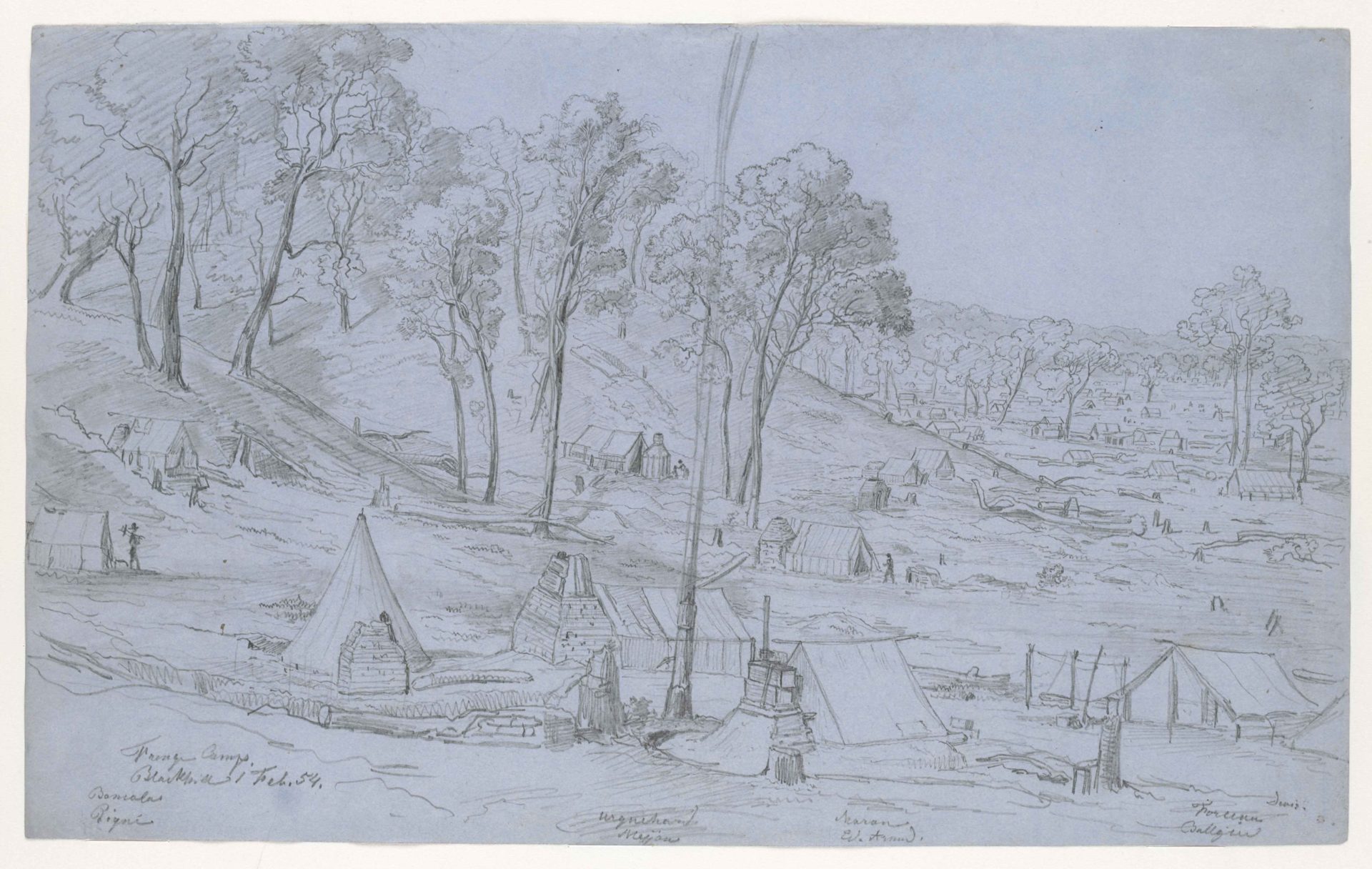People from Many Lands
The multicultural layered history of Australia is a partly hidden element of the Australian national psyche and the telling of the goldfields story. The roles played in formulating our open and broadminded Australian democracy are often overlooked.
Many people brought with them different customs, clothes, languages and ideas. They came as convicts, servants, soldiers, farmers, tradesmen, and officials. Women and children came too. Sometimes women were single. They were widows, sisters, and daughters. Sometimes they were married. There were around 30 different nationalities listed during the Eureka Affair in 1854. These have been documented by Clare Gervasoni and Dorothy Wickham.
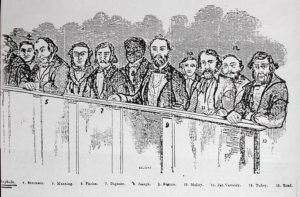
The reasons for leaving homelands were varied. There were global issues affecting the world and the goldfields. The Chartist Movement had been quelled in England; Irish troubles were ongoing; and the 1848 upheavals in Europe affected many.
Customs were different. Dutchmen always wore red trousers. Chinese dressed differently. Scottish bagpipes were played.
Family groups and village groups came to the goldfields. Groups emigrated from Italy, Germany and Scotland. Whole villages came to the goldfields.
The role of foreigners, including women were many and varied. They travelled to the major goldfields of Castlemaine, Bendigo, and Ballarat, as well as smaller places like Avoca, Landsborough, and Ararat.
The Royal Commission into the Gold Fields 1854-55 concluded that ‘The share borne by foreigners in this outbreak has been the subject of frequent comment and been rather variously represented’.
James Madden fifty years after the Eureka Affair wrote that:
... I say, from an intimate knowledge of events, that Englishmen, Irishmen, Scotchmen, and men from other European countries, fought together and so did men of every religion. My family are Ulster-Protestants, and the latter are not usually weak in their faith, and we had many friends, also strict Irish Protestants, who fought and died side by side-with men of all other creeds; among them Irish Catholics. The struggle was one in which all religions united, so great was the oppression; and so strong was the desire to gain for Australia the freedom we have to-day.
In 1954 L.G. Churchward, historian and member of the centenary committee, observed that ‘The role of foreigners in the Eureka Stockade has been the subject of debate from the eve of the rebellion right up to the present’. Churchward thought that many historians had been influenced by the view that the rebellion was ‘un-British’ such that ‘honest British miners’ must have been led astray by ‘foreign agitators’.
Americans on the Goldfields
Benajmin Mountford and Stephen Tufnell have written extensively on the transnational influences between the American and Australian goldfields. Should you want to explore the goldfields further a chapter written by Ben and Steve can be found in the interesting book Pay Dirt: Ballarat & Other Gold Towns. Pay Dirt! Something very valuable or very useful that is found after searching or effort.
This publication comprises an eclectic mix of writing styles and topics by authors, all leading experts in their respective historical fields. The foreword by Emeritus Professor Geoffrey Blainey presents to the reader a tantalising glimpse of the following chapters. Written by 17 contributing authors this book is in full colour, with ‘evocative illustrations’, and ‘unexpected topics’. Celebrating the 21st Birthday of BHS Publishing, it offers new perspectives and different view points, setting fledgling Victoria in a global context. Meticulously and conscienciously researched, it brings to life the culture of the goldfields, hidden aspects of identity, Aboriginal life and corroboree, women, conquest and suffering.
https://ballaratheritage.com.au/bookshop/pay-dirt-ballarat-gold-victoria-eureka/
Names - American
Connections with Eureka 1854. http://eurekapedia.org/United_States_of_America
At the Royal Commission into the Gold Fields Commissioner Rede was asked whether 'there were many Americans passing between the diggers and the Camp, either giving information or in any other way aiding the rioters'. John Pascoe Fawkner, the American member of the Commission then reframed the question. "There were two or three Americans who were constantly in the habit of coming up to the Camp, professing to give information?" Commissioner Rede replied that it was Charles Kenworthy who gave him information about the quartz veins. Kenworthy, a doctor, offered his expertise to the stockaders. He tried to dissuade his countrymen from participating in the battle. William Bramwell Withers asserts that Kenworthy was present at the writing of the Reform League Charter, a 'declaration of independence'.
Others
Cobb & Co.; Thomas Byng;
French on the Goldfields
The influence of French speakers has been significant on the Victorian goldfields but this group has been consistently overlooked in mainstream historical discourse. Although we can derive a parallel colonial history to our own British history, in imperial terms, the French people who emigrated and settled on the Victorian Goldfields have rarely been explored. This much needed area of research will highlight the lives of French speakers in Victoria from the times of the early gold rushes in the 1850s. It is envisaged that this project will deliver a social and cultural history that represents the diverse stories: the hopes; dreams; disappointments and achievements; of French speakers who left their homeland to travel to the antipodes.
The French showed an interest in Australia even before European settlement and the landing of the first fleet in 1788. Charles de Brosses’s Histoire des Navigations aux Terres Australes appeared in 1756 giving stimulus to the exploration of the Pacific. Louis Antoine de Bougainville, scientist, soldier and navigator despatched in 1767 by Louis XVI investigated the extent of the Unknown South Land and circumnavigated the world.
In the 1850s, French-speaking foreigners from around the world gathered in the Café Estaminet in Little Collins Street, Melbourne, and the 500 members of the French Society of Victoria in the 1880s included people from several nations. Long before this, French explorers had explored the coast of Victoria, leaving traces of their language in the form of names given to the bays, inlets and peninsula of South-Eastern Australia.
A multicultural French establishment is the Australian newspaper Le Courrier Australien , the oldest surviving French-language journal outside of France as well as Australia’s oldest foreign-language newspaper. It was founded in 1892 by a Polish man, Karol de Wroblewski, and was later purchased by Léon Henry Magrin, a Mauritian.
Channel Islands
The clipper-brig Secret, Mr HILARY MARQUAND master, destined for Melbourne with passengers and a general cargo, is now ready for sea and awaiting a fair wind to take her departure. This snug, comfortable craft has been built expressly for the Australian trade. Her accommodations, considering the size of the vessel, are excellent. The owners have spared nothing that can contribute to the comfort and convenience of the passengers; and from the knowledge we have of her intelligent and affable commander, we feel assured that he will do everything within the compass of his power to promote the well-being of those under his care. The chief-officer, Mr OGILVIE, is an experienced mariner, who, we know, will not be backward in co-operating with his master towards rendering a long sea-voyage as little tedious as possible.
We append a list of the passengers: Helier Mahy, Julien Hardy, Abraham Le Page, Henry Ogier, Abraham Domaille, James Falla, John Le Gallez, Mrs. White and daughter, Mr. Etchells and sister, Mr Brewer, Miss Corbet, John P Ogier, Miss Le Page and brother, Mrs Le Patourel and son. The crew consists of the master, two mates, eight men and a boy.
Reference: https://www.priaulxlibrary.co.uk/articles/article/january-1854-australia
Names - French
Jean Marie Ballaguy (French Lodge, Ballarat 1850s, hotelier, gentleman); Ann Marie Blampied (ADB); Hope Charles Bonneau, Melbourne Merchant, n.d.; Mr Brewer (Emigrated on Secret); Miss Corbet (Emigrated on Secret); Thomas Decueur (French Lodge 1853 Ballarat); Delprat (French Lodge 1853 Ballarat); Abraham Domaille (Emigrated on Secret); Paul Dufour (French Lodge 1853 Ballarat); Mr. Etchells and sister (Emigrated on Secret); James Falla (Emigrated on Secret); Antoine Julien Fauchery (photographer, Victorian goldfields 1850s); Monsieur Feton or Fiton (French Lodge 1853 Ballarat first Worshipful Master) Possibly Edward Fiton who was prominent in Masonic circles for many years. See A. A. W. Steane, Freemasonic Records: Ballarat and District 1854-1957, Ballarat & District Lodges, 1957, p. 7.; Achille Fleury (French Lodge 1853 Ballarat); John Le Gallez (Emigrated on Secret); Gillot or Guillerot (von Guerard's diary and sketches, Ballarat resident 1854); Julien Hardy (family history Wickham); James Harrison (Born Calais c1843, was in Ballarat 1858); R. A. Q. Heriques, poundkeeper, Shepparton Pound (late McGuire's Punt) 25 November 1854; Alfred Lautour (Government Gazette 1854, p.1555); Abraham Le Page (Emigrated on Secret); Miss Le Page and brother (Emigrated on Secret); Mrs Le Patourel and son (Emigrated on Secret); Helier Mahy (Emigrated on Secret); Etienne Marthe (French Lodge 1853 Ballarat); Victor Milat Etienne Marthe (French Lodge 1853 Ballarat); Henry O'Gier (Emigrated on Secret - also spelt Ogier); John P Ogier (Emigrated on Secret); Nicholas O'Gier(Emigrated on Secret); Le Pere (Eureka 1854); Marie Petitjean (witness to Hardy-Burchardt marriage 1858 Melbourne); Peter Priaulx (French Lodge 1853 Ballarat); Le Fronzis Romeo (Born French Corsica, at Eureka 1854); Laurent Roustan, (Obit, Gordon Advertiser 15 February 1901); (E. Termeaux (French Lodge 1853 Ballarat); Tinzel (French Lodge 1853 Ballarat); Jean Pierre Troutte (ADB); Mrs. White and daughter (Emigrated on Secret)
Jean Marie Ballaguy and Maria Bean both 'of full age' married on 15 July 1845 in the Parish of Christ Church in the County of Surrey, England according to Church of England rites. His occupation was recorded as a hatter, his father being Jean Marie Ballaguy a cotton manufacturer. Her father was recorded as John Bean, a tailor. Both parties to the marriage Jean Marie and Marie were living at 12 Southwark Bridge Road.
Ann Marie Blampied (c.1825-1905) and her brother Emile (c.1837-1914) from Meurthe-et-Moselle, Lorraine, north-eastern France, who had reached Melbourne in 1853. Jean-Pierre married Anne on 9 April 1856 at St Monica's Chapel, Heidelberg, with Catholic rites. In 1858 the Trouettes and Emile Blampied took over a vegetable garden on Concongella Creek, Great Western, and purchased twenty-seven acres (10.9 ha) freehold about 1862, the year Trouette was naturalized. Sludge and gravel were cleared and fruit and vegetables sold to miners at Lamplough, Redbank and Landsborough.
Le Pere DELPRAT (DUPRAT) was a respected French goldminer on the Ballarat goldfield. Carboni says Duprat was in the Eureka Stockade. [Ref: ES]
GILLOT or GUILLEROT - (possibly Guillerot who was mentioned in Eugene von Guerard’s diary), a Ballarat resident in 1854 was in partnership with Binney who had known Carboni at Canadian Gully. Binney sold Carboni’s book The Eureka Stockade.
HARRISON was born in Calais, France to parents James Harrison and his wife, Mary Ann Stevenson who were both lace makers and originated from Nottingham. They had married at St. Mary the Virgin church in Dover, England on 15 December 1840. This son, James, joined them in Ballarat when he was about fifteen years old in 1858. A daughter, Mary Ann, was born to them in Ballarat in 1854. Mary Ann and William were also born in Ballarat in 1856 and 1858 respectively. James Harrison died on 27 June 1880, his address at the time being Humffray Street, Ballarat East. He is buried at Ballaarat New Cemetery.
Henry O'GIER
Henry O'Gier b.20.5.1836 St. Sampson, Guernsey, son of John Peter O'Gier and Judith Renouf travelled to Australia with his father on the ship "Secret". They departed Guernsey 2.2.1854 and arrived in Melbourne on 2.5.1854.
Henry's brother Nicholas had arrived in Victoria in 1852 and settled in Clunes, north of Ballarat. Their sister Lucy had arrived by ship in 1853. Henry joined Nicholas in Clunes.
Henry married 1869 Martha Danks. They lived in West Street, Clunes and had 11 children: John Henry b.1868, Eliza Mackey b.1870, George William b.1872, Frederick Thomas b.1874, Charles Edward b.1876, Ada Louisa b.1878, Albert James b.1881, Ethel Harriet b.1883, Lucy Pearl b.1885, Ernest Edgar b.1886, Eva Constance b.1888.
Lucy Pearl died of diphtheria at the family home in West Street, Clunes c1890. She was aged 5 years 8 months.
Some time around 1895, Henry and three of his sons, George (age 23 years), Frederick (age 21 years) and Albert (age 14 years) travelled to Boulder in Western Australia. Henry left his wife Martha at home in Clunes with their eldest son John and daughter Eliza. Their youngest child at that time was only 7 years old.
On 26th June, 1899, Frederick died. The local Clunes newspaper published his obituary :
Mr. Frederick O'Gier died at Dr. Sawell's hospital on Monday night last after a short illness of nine days, of pneumonia and fever. The deceased, who has resided in Boulder district for over three years was born at Clunes, Victoria in 1874, being only 24 years and 9 months.
He was one of the first members of Queen's Church Sunday school Band of Hope, of Boulder City. He was connected with the Boulder Literary and Debating Society, the Queen's Star Football Club, and a member of the Saturday Cricket and Football Association.
Henry and his sons lived at 430 Hopkins Street, Boulder and after a short funeral service conducted at their house by The Rev. T. Allen, Frederick was buried at Kalgoorlie cemetery. The Queen's Church choir and friends sang at the house and at the cemetery. Reference: First Families 2001
Le Fronzis Romeo was born in French Corsica in 1839, but probably originated from Siena, Italy. His correct name was De Romeu. His French Corsican family had blood ties with Bonaparte. Romeo shared a tent with the Jan Vennick and Cornelius Peters. The tent was 150-130 yards north of the Eureka Stockade (1854). Romeo was one of 114 arrested after the Eureka battle, and one of 11 foreigners arrested. He left a French Man-O-War at Melbourne about 1851 and was then aged 16 years. He married Elizabeth Hyder at Creswick in 1874. Romeo died in 1910 and is buried at Creswick cemetery. [Eureka Wiki]
Laurent Roustan, Born Marseilles c1835, he came to Ballarat and took part in the Eureka Affair of 1854, then moved to Gordon near Ballarat by 1858. His obituary in the Gordon Advertiser states that he: 'died on Tuesday morning from paralysis, aged 66 years. Native of Marseilles, France. On landing in Victoria he journeyed to Ballarat and took part in the historic Eureka riot and other stirring scenes enacted there in 1854. Came to Gordon in 1858'.
Jean-Pierre Trouette (c.1833-1885), vigneron, was born at Estampes, Gers, south-western France, son of Pierre Trouette, farmer, and his wife Marie Jeanne, née Sorbet. As a young man, Jean-Pierre went to Montevideo, probably to avoid army service. After three years in Uruguay he travelled to Adelaide in 1853 and, while working in the mines at Burra, heard of the gold discoveries in Victoria.
At Daylesford he met Ann Marie Blampied (c.1825-1905) and her brother Emile (c.1837-1914) from Meurthe-et-Moselle, Lorraine, north-eastern France, who had reached Melbourne in 1853. Jean-Pierre married Anne on 9 April 1856 at St Monica's Chapel, Heidelberg, with Catholic rites. In 1858 the Trouettes and Emile Blampied took over a vegetable garden on Concongella Creek, Great Western, and purchased twenty-seven acres (10.9 ha) freehold about 1862, the year Trouette was naturalized. Sludge and gravel were cleared and fruit and vegetables sold to miners at Lamplough, Redbank and Landsborough. In 1863 half an acre (0.2 ha) of vines was planted for fresh fruit. By 1866 the vineyard consisted of more than fifteen acres (6.1 ha) with enough grapes to make table wines. At the Intercolonial Exhibition in Melbourne that year connoisseurs noticed Trouette's well-made wines. His varieties included 'White Nice', chasselas, riesling and esparte (mourvedre). A prize-winning red wine in 1867 was 'clean and full, yet delicate of flavour'. The complex took the name St Peter's. Other vignerons followed their example at Great Western, notably the brothers Best.
In 1873 Emile Blampied married Louise, daughter of Louis Metzger, an Alsatian-born winemaker from nearby Doctors Creek. By 1878 the partnership had 200 acres (80.9 ha) with orchards, and forty-five acres (18.2 ha) under vine, with cellar storage and a two-storey building; the vineyard would later reach 110 acres (44.5 ha) and the Trouette children Nicholas and Marie were groomed to take over the enterprise, which employed six people and thirty extras at vintage. Jean-Pierre was a shire councillor at Stawell and sold wine there, although he complained that publicans undercut him with 'doctored' material.
Trouette was a talented viticulturist and winemaker. Old World experience helped him, but he was resourceful as well; close planting was abandoned early. The soil that he considered unremarkable, a mixture of clay and loam, produced the finest grapes. More important was the climate, as good as the South of France without its devastating storms. Champagne method sparkling wine appeared in 1882.
St Peter's was famous for its vintage and holiday festivities, attracting travellers from Ballarat, Melbourne and Geelong. Hubert de Castella visited on the Queen's birthday in 1882, when food, wine, toasts, singing and dancing were enjoyed well into the night. Madame Trouette was 'tall and strong', wearing traditional Lorraine dress, only 'a little bowed by her toil'; her brother Emile, 'large and handsome', had a face 'which inspires confidence from the first', and Jean-Pierre was 'hospitable to the last'.
Trouette died of pulmonary tuberculosis on 24 November 1885 at Great Western, and was buried in the local cemetery. His wife, son and daughter survived him, inheriting an estate sworn for probate at £7461. Next year, however, Nicholas and another worker were asphyxiated in an underground wine tank. The cumulative effects of personal loss, crop failures, bad seasons and economic depression led to the sale of the property in 1894 to purchasers with no interest in winemaking. The Blampieds, whose share had been a third, moved to Nhill. St Peter's vineyard and winery did not survive but winemaking, which the French migrants had pioneered at Great Western, flourished. [David Dunstan, 'Trouette, Jean-Pierre (1833–1885)', Australian Dictionary of Biography, National Centre of Biography, Australian National University, http://adb.anu.edu.au/biography/trouette-jean-pierre-13224/text7937, published first in hardcopy 2005, accessed online 31 October 2018. This article was first published in hardcopy in Australian Dictionary of Biography, Supplementary Volume, (MUP), 2005]
References:
Australian Dictionary of Biography
First Families 2001
Manuscripts: Central Freemasons Archives, London
Websites
Gervasoni & Wickham, Eureka: A Multicultural Event. See https://ballaratheritage.com.au/article/eureka-a-multicultural-affair/
http://adb.anu.edu.au/biography/trouette-jean-pierre-13224/text7937
http://eurekapedia.org/Country_of_Origin
January 1854: Off to Australia. See https://www.priaulxlibrary.co.uk/articles/article/january-1854-australia
Newspapers
Gordon Advertiser 15 February 1901
The French Lodge in Australia
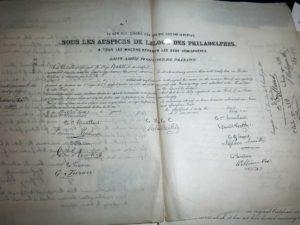 The Loge de Philadelphes, shrouded with mystery and intrigue, has been connected to radicals and revolutionaries throughout its troubled life.(1) Attached to the principles of tolerance, freedom of thought, and dealing in esoterics and symbolism, its popularity waxed and waned, influenced by politics and religion.
The Loge de Philadelphes, shrouded with mystery and intrigue, has been connected to radicals and revolutionaries throughout its troubled life.(1) Attached to the principles of tolerance, freedom of thought, and dealing in esoterics and symbolism, its popularity waxed and waned, influenced by politics and religion.
Defunct in France, then reinstated, the lodge survived, and ultimately was reinstated once more by French nationals in London (England), Brussels (Belgium), New York (America) and Ballarat (Australia). Its members have included princes, revolutionaries and famous dignitaries.
The Warrant for the French Lodge in Australia dated February 1851 and signed from Vallee de Paris is housed in the central Masonic archives in London. It has been signed by many Masons, assumed to be in the French Lodge, The Loge de Philadelphes de Memphis.
The Rameau d’Or d’Eleusis which, translated into English, was the Branch of Gold of Eleusis, was the first French lodge that operated in Ballarat, in the Colony of Victoria, Australia. The use of the word “gold” was possibly a reference to the rich goldfields of Victoria, while the word Eleusis derived from the Eleusinian Mysteries, an Athenian festival held for over two thousand years, in honour of the grain and fertility goddess Demeter. It thus could be taken to mean more broadly “gold and fertility” and was probably a reference to the prolific wealth that potentially was to be wrestled from the land on the goldfields of Ballarat. Among the members of the French Lodge were men with names such as Paul Dufour, E. Termaux, Archille Fleury, Tinzel, Etienne Marthe, Victor Milat, A E Collas and Monsieur Feton or Fiton who was appointed the first Worshipful Master. Possibly Edward Fiton who was prominent in Masonic circles for many years. See A. A. W. Steane, Freemasonic Records: Ballarat and District 1854-1957, Ballarat & District Lodges, 1957, p. 7.
Document One - 1851
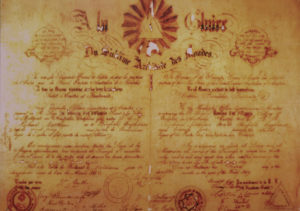 Au Nom Du Gra Hierophante Sous les auspices du G Empire ordre Mac de Memphia A tous les Macons repar sur les deux Hemispheres
Au Nom Du Gra Hierophante Sous les auspices du G Empire ordre Mac de Memphia A tous les Macons repar sur les deux Hemispheres
Salut, amitieraternite A toutes les Loges, Chapitres Areopages, Senats, ? ? notre Rit antique et primitive Union, Presperite, Cove, Force, Tolerance Nous G. Hierophante Souv Ponife G.M. Lumiere et Membres composant le G. Empire de
Ordre Mac. De Mephis faisons savoir, que le Fr. Ballaguy (Jean Marie)
Age de quarante ? Motif de Villefranche Departeur Rhone Il a del eleve a la dignite de Souverein Prince Chevalier Rosecrois 18 degree ? notre ordre En consequence, nous invitens et prions on vertu des pouvoers suppor6 nous sommes revetus en nos susdites qualities toutes les Loges Chapitres Senats et Conseils de reconnaitre en sa qualite notre Ch Ballaguy de l’accucillir fraternellement et de lui priter aide ? protection au besoin deserant qu’il jouisse des droits et prerogatives qui ? accordis parles statuts generaux de l’Ordre. Ouvre: fous en ca presence portiques de uos Temples Orient venore jette tes plus eclatautes splendeurs que les doiles du ? nombres sacred a dau un Ordre mysterieux, viennent a sa rencontre! Que l’harmonie celeste cilebie sa venue! Que l’dendard d’eroule devant lue sa plis glorieux! En que N. F. penetre daus le Temple environne des hommeurs diu a son eminente qualite. Fait dans le Sandiaire vie repose l Arche vinerie des trade lieu eclaire d’un rayon divin vie rigne la paix, la vertu, la scince et lie plenitude de tous les biens
Translation
In The Name Of Hierophant Grate Under the auspices of the G Empire Mac order of Memphia To all Macons back on both Hemispheres Hi, amitieraternite To all the Lodges, Areopages Chapters, Senats,? ? our ancient and primitive Rit Union, Presperity, Cove, Force, Tolerance We G. Hierophante Souv Ponmi G. Light and Members composing the G. Empire of Mac order. From Mephis let us know that Bro. Ballaguy (Jean Marie) Age of forty? Villefranche motif Departeur Rhone He has elevated to the dignity of Souverein Prince Chevalier Rosecrois 18 degree? our order Consequently, we invite and pray that, under the authority of the authorities, we are vested in our aforesaid qualities with all the Senate and Council Lodges and Councils to recognize in our quality our Ch Ballaguy to fraternise him and to help him? protection if necessary that it enjoys the rights and prerogatives that? granted by the general statutes of the Order. Open: mad, in the presence of porticoes of your Temples Orient venore, throws your most splendid splendours that the doiles of? sacred numbers to a mysterious Order, come to meet him! That harmony celeste cilebie his coming! Let the darling roam before his glorious folds! In which N. F. penetrates in the Temple surrounds the men of his eminent quality. Done in the sandiary life rests the arche vinerie of the trade place illuminated with a divine ray life rigns the peace, the virtue, the scince and the plenitude of all the goods
References
1. The Rite of Memphis in France and England 1838-70, Inaugural address by Brother Ellic Howe, 9 November 1978, Ars Quatuor Coronatum, Volume 92, 1979, pp. 1-25, Central Masonic Library, London.
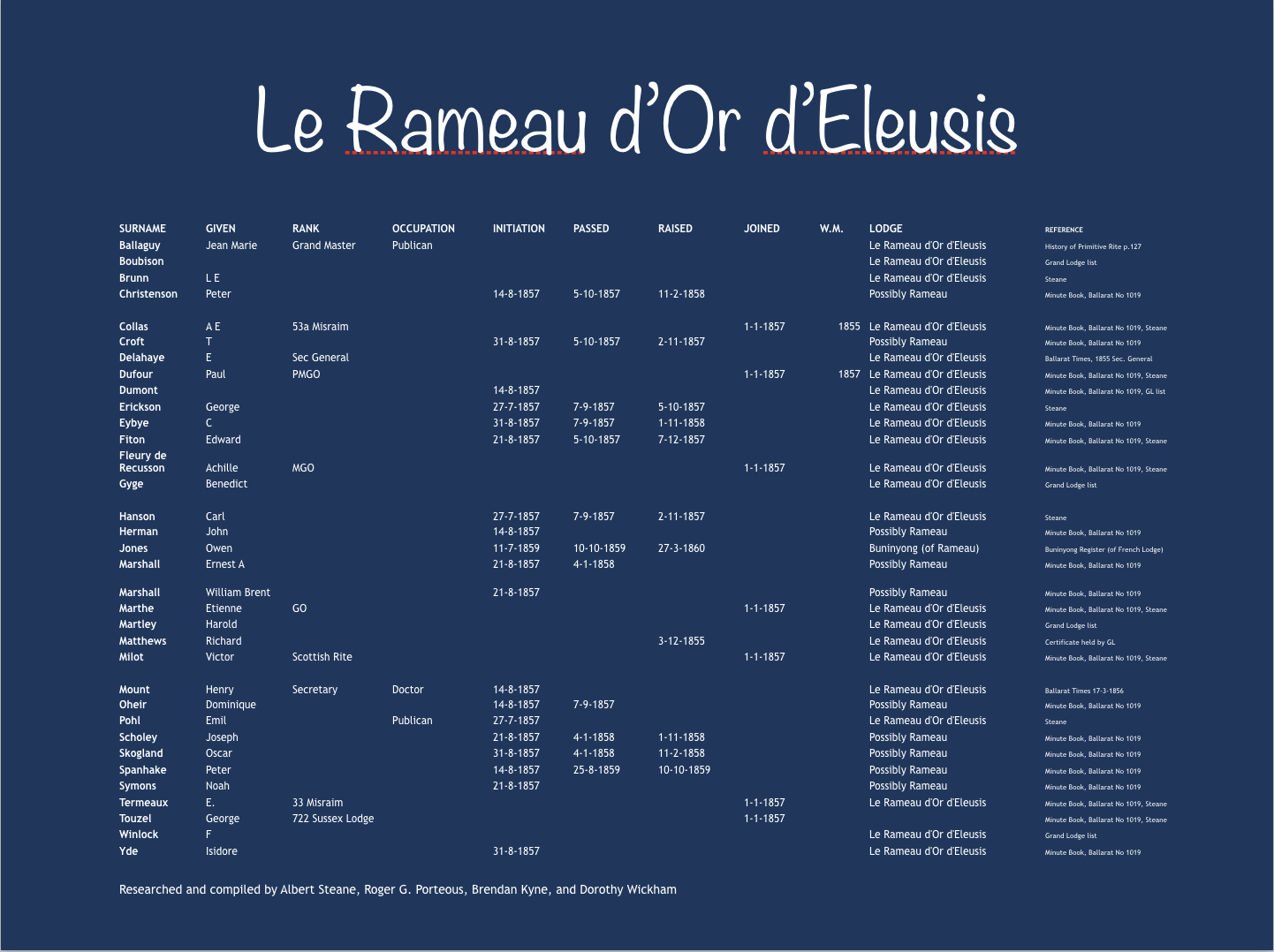
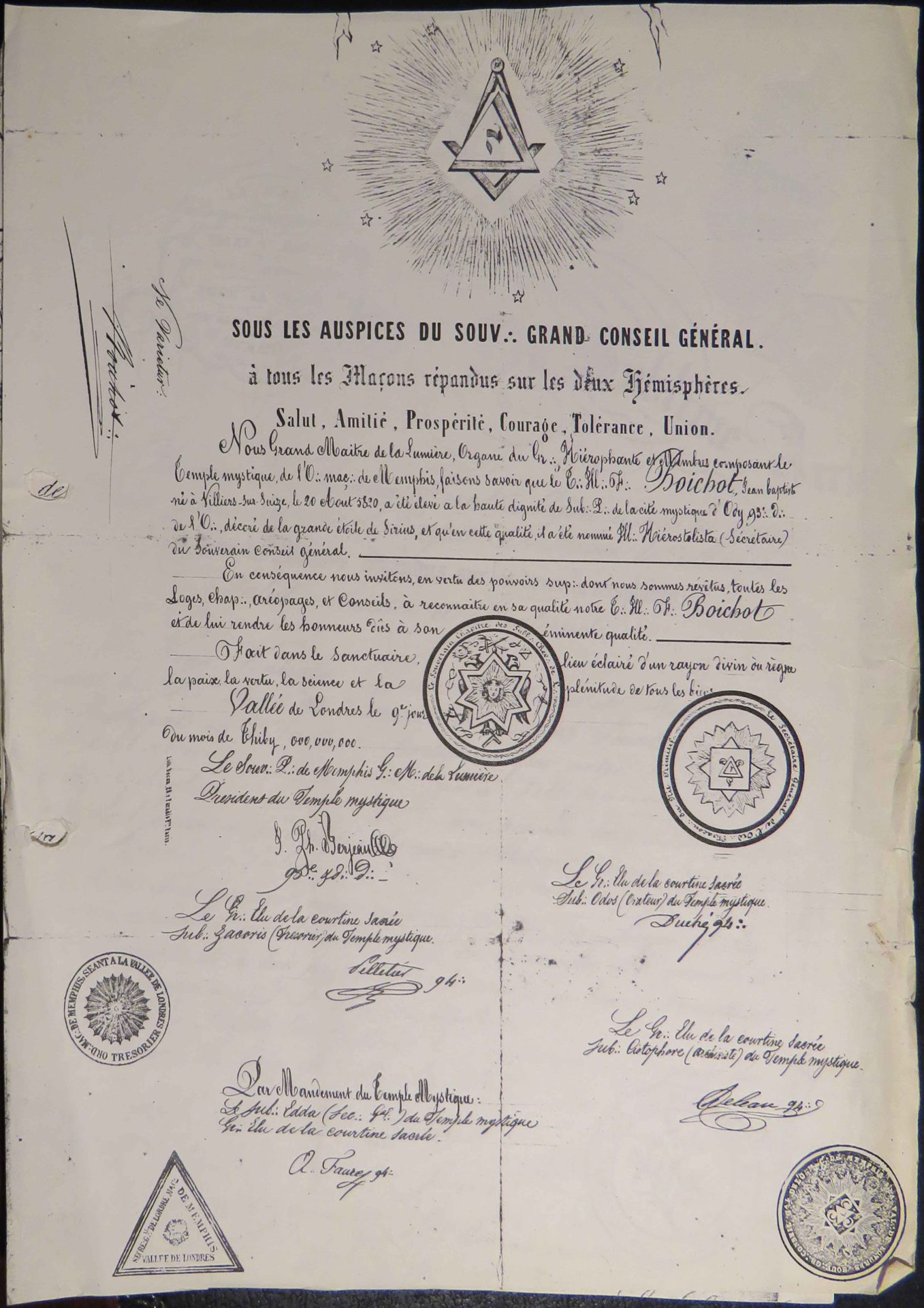
The French Lodge carries the name of Monsieur Jean Marie Ballaguy, head of the Lodge in Australia, and living at Ballarat, Victora. In the early 1850s he lived at Black Hill where many French people had settled. Eugene von Guerard sketched the area in February 1854. He later painted the scene which shows a tent store/hotel flying a French flag. It is thought that this is the hotel called the Ballaguy that was situated on Black Hill and where the first French Lodge meetings were held.
